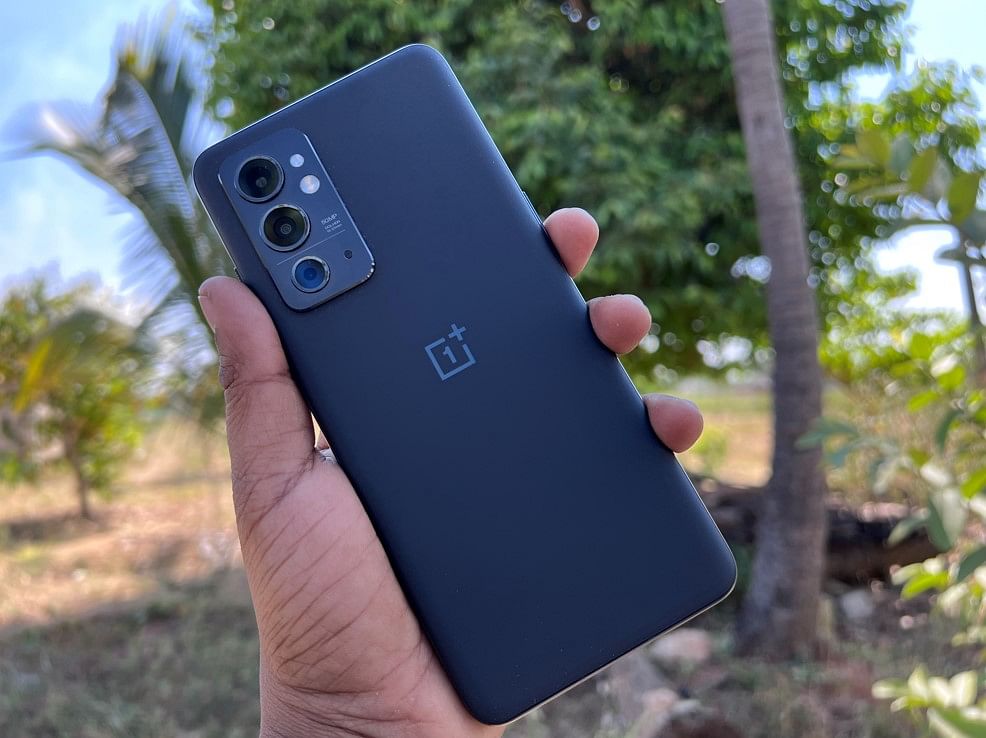
OnePlus 9RT comes with a good upgrade over the predecessor both in terms of design and internal hardware.
It comes in two colours— Nano Silver and Hacker Black colours. It is availale two configurations— 8GB RAM + 128GB storage and 12GB RAM + 256GB storage— for Rs 42,999 and Rs 46,999, respectively.
Considering the price and specification, OnePlus 9RT seems to be a value-for-money phone, but does it deliver the goods? Let's check it out.
Design, build quality, and display
Our review unit is the OnePlus 9RT hacker black model. It t comes with a visually appealing matte finish and also does an excellent job in terms of repelling fingerprint smudges. There is a nanosilver variant and it also looks good.
The device features a premium aluminium rail around the edges, which not only offers a really good grip for the fingers to hold on to the device but also gives stability to the compact structure of the phone.
The device is protected by Gorilla Glass 5 shield on both the front and back, offering protection against scratches from coins, or pens or keys, when the device is kept in the pant pocket.
Add to that, the company offers a matching soft silicone cover with the retail box and also pre-applies another layer of a plastic screen guard, which further enhances the durability of the device.
On the front, it sports a 6.62-inch full HD+(1080 x 2400p) AMOLED screen and it cascades up to the middle of the rim, which enhances the visual appeal of the phone.
It has 87.9 per cent screen-to-body ratio and offers a good viewing experience. The display bright and colours in the multi-media content played on it, looks vibrant and rich. I loved watching documentaries on the phone.
The display also supports 600 Hz Touch Response and 4D Haptic Motor inside, which come handy while battle royale games and offer trully enhanced playing experience.
The in-display fingerprint sensor works fine. It recognises the finger impression fast and quickly opens the screen.
Performance
OnePlus 9RT is powered by 5nm class Qualcomm Snapdragon 888 (2.84 GHz Kryo 680 x 1 + 2.42 GHz Kryo 680 x 3 + 1.80 GHz Kryo 680 x 4) octa-core processor backed by Adreno 660 GPU with 8GB/12GB RAM and 128GB/256GB storage.
Our review unit worked fine in all tasks be it opening apps, operating cameras and even playing graphics-rich gaming apps. With the Vapor Chamber cooling system in place, I did not face any pressing issue of over-heating while any tasks.
However, the only qualm is that the device runs two-year-old Android 11-based OxygenOS. It is a known fact many OEMs (Original Equipment Manufacturers) are having trouble optimising Android 12 to their respective phones, and it is the same for OnePlus too.
Though the new OnePlus phones are coming with the latest OxygenOS 12, the company is taking its own sweet time to bring the same for the OnePlus 9RT. Hopefully, it happens soon and comes free of bugs.
On the bright side, the device has a clean user interface and no bloatware, which is very refreshing considering the fact that most Android phones in all price ranges come with a lot of unwanted apps and a layer above Android skin, which makes it hard for first-time smartphone users to get the hang of the user-interface.
It comes with a 4,500mAh cell capacity and delivers a full-day battery life under normal usage.
However, if you use cellular data instead of Wi-Fi, the battery drains really fast and it is common in any phone.
It won't be a major problem, as the device's retail box comes with 65W Warp Charger, which can fully power up the phone from zero to 100 per cent in around 30 minutes.
OnePlus 9RT supports multiple 5G Bands, making it a future-ready phone.
[Note: 5G Bands--NSA (N1, 3, 5, 8, 40, 41, 78); SA:N1, 3, 5, 8, 28A(703-733MHz); TDD: N40, 41, 78]
FYI: In India, the commercial operation of the 5G service is expected to take off by the end of 2022 or early 2023.
Photography
OnePlus 9RT features a triple-camera module-- main 50 MP (with f/1.8, 24mm wide lens, 1/1.56-inch, 1.0µm, PDAF, OIS: Optical Image Stabilisation) + 16 MP (f/2.2, 14mm, 123-degree ultrawide 1/3.6-inch sensor, 1.0µm) + 2 MP macro (f/2.4) sensor with dual-LED flash.
It takes really nice pictures in sunny conditions and even in the normal camera mode, the edge detection is pretty good. Also, the background gets subtly blurred and does not come off as artificial.
As you can see from the wide-angle photos, the phone has done a good job of accomodating the wide expanse of the grassland with the Nandi hill range in the backdrop. The optical zoom too looks fine, as there is less loss of image quality.
The night mode picture too has come off fine with a cloudy outcast in the background captured with details and also the street lights on the buildings and trees don't blow out and are well balanced and look natural as seen through our eyes. But, of course, the clouds seem a tad brighter than normal, but that's what makes the photo presentable. The native camera app has done a good here.
The device can record videos up to 4K resolution at 30/60fps (frames per second), and full HD (1080p) at 30/60/240fps. With gyro-EIS (Electronic Image Stabilisation), the videos come off stable on par with rival brands in its class.
On the front, it houses a 16 MP wide camera (f/2.4, 1/3.06-inch sensor, 1.0µm pixel size). With Auto HDR on, it takes pretty decent selfies and also the video is also recording is also really good in its class.
Final thoughts
The design language and internal specification don't make the device stand out from the competition, but the bloat-ware apps-free and clean user interface make the user experience pleasant and compelling phone to buy.
The camera capability is on par with any of its peers in the sub-Rs 45,000 price range. The only qualm is there is no word on when Android 12 will be released, but whenever it does get rolled out, we hope it comes without any bugs.
Get the latest news on new launches, gadget reviews, apps, cybersecurity, and more on personal technology only on DH Tech.
